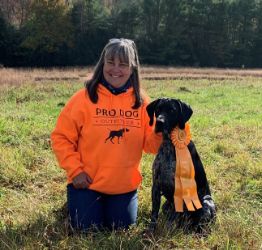
Home » Coming to a Show Ring Near You: The Black/Black & White German Shorthaired Pointer
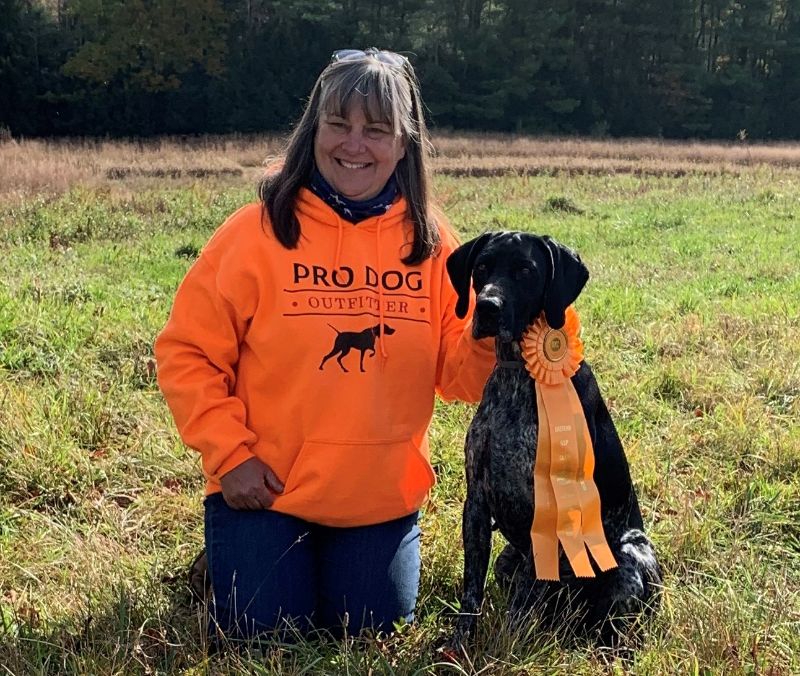
The AKC Breed Standard for German Shorthaired Pointers has not had a change since 1992. However, as of January 1, 2023, it will state the following in the areas that have a reference to color:
Nose – The nose is brown on a liver dog and black on a black dog. The larger the nose the better and nostrils should be well opened and broad. A spotted nose is not desirable. A flesh colored nose disqualifies.
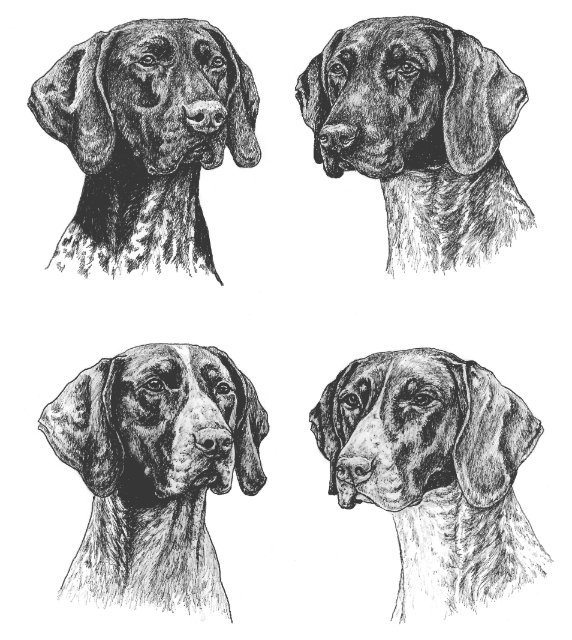
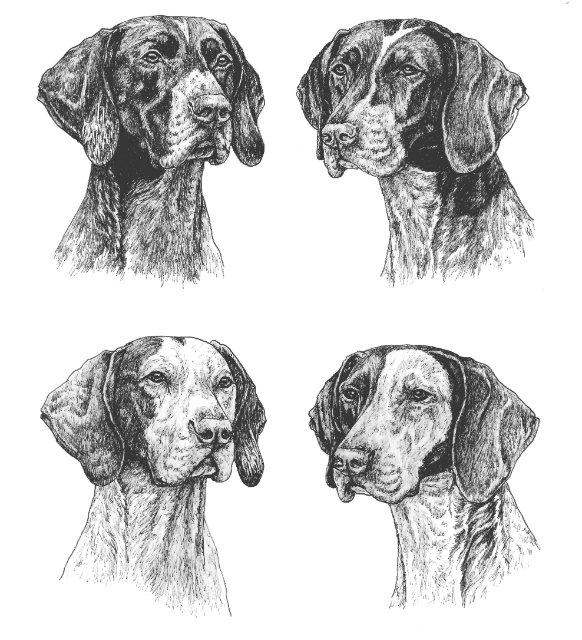
The coat may be of solid liver or a combination of liver and white such as liver and white ticked, liver patched and white ticked, or liver roan. Or the coat may be of solid black or any combination of black and white such as black and white ticked, black patched, and white ticked, or black roan. Any other color or color combination is a disqualification. A dog with an area of red, orange, lemon, or tan, or a dog solid white will be disqualified.
Yes, you read that correctly. In addition to liver and liver & white combinations, black or any combination of black and white will be an acceptable coat color for German Shorthaired Pointers. Black and black & white German Shorthaired Pointers in the same coat patterns as their liver counterparts will be competing in a show ring together.
No preference should be given to one coat pattern over another when the conformation of a GSP is being judged.
Head markings can also vary widely. Solid heads, heads with a spot, thin blazes, wide blazes, uneven blazes, and even heads being mostly white are all acceptable. As with coat patterns, the Breed Standard does not state that a preference should be given to one over the other when judging conformation.
I am going to state that again, because it is worth repeating: Coat patterns and head markings should have no influence when evaluating conformation and type. It is also important to note that a GSP must NOT have both colors of black and liver present. It is one or the other.
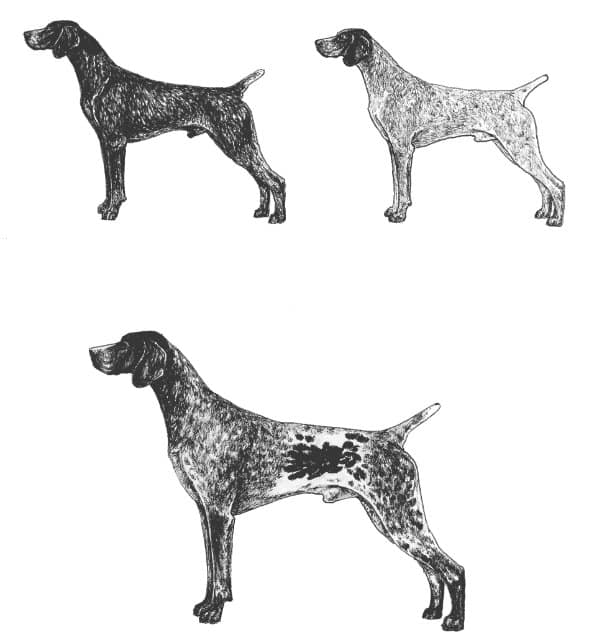
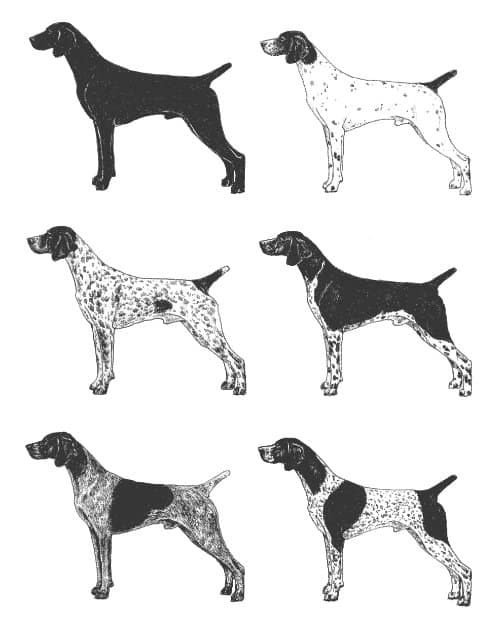
No preference should be given to one coat pattern over another when the conformation of a GSP is being judged.
Black has been an acceptable coat color for German Shorthaired Pointers in Germany, the country of origin, since the 1930s. In the late 1800s, German Shorthaired Pointers were brown, black, or red. Brown was initially preferred, so the blacks and reds were no longer used in breeding programs.
In 1907, two prominent breeders sought to improve the light eyes, pale pigment, and lack of air scenting abilities in their dogs. They imported a black Arkwright Pointer bitch and bred her to a GSP stud. From that mating a solid black bitch pup was kept and bred to another German Shorthaired Pointer stud. This continued with get from each successive generation, as subsequent breeders began to use these offspring to improve quality and field performance as well. By 1934, descendants of that initial Arkwright Pointer/GSP cross were deemed purebred, with the black-coated dogs included in the German studbook with the liver-coated dogs.
In 1926, the first documented import to the United States was a heavily ticked and patched liver bitch from Austria. The breed was recognized by the American Kennel Club in 1930 and a Breed Standard by the National German Shorthaired Pointer Dog Club was accepted in 1935. That Standard, stating the black coat or tri-color as a fault, appears to have been loosely translated from the 1902 German Standard, which, of course, was several years before black was re-introduced. So, this seems to be a reasonable explanation for the omission of black.
While black and black & white German Shorthaired Pointers had been accepted in much of the rest of the world, they have been considered taboo here in the US by show breeders. The concern was that black and black & white GSPs were the result of cross-breeding with field Pointers and Setters by field trialers seeking a bigger-running dog. However, folks truly interested in the performance aspect of our breed took an interest in the purebred black GSPs of Europe and began importing and breeding them many years ago.
It has not been unusual to see black GSPs in Field Trials, Hunt Tests, Obedience Trials, and all other Performance events. As a matter of fact, a solid black bitch was the GSPCA Open Gundog of the Year in 2011 and then won the GSPCA National Gundog Amateur Championship in 2012, and a black & white bitch was High in Trial at the National Specialty Show in 2000, 2003, and 2006! Black has been listed as a color choice on registration applications for many years, even though it has been a disqualification for the Conformation show ring.
For me personally, I encountered my first black GSP somewhere around 1990; a lovely girl imported from a well-known Australian Kennel. Things, of course, were much different then, with no social media to expose us to anything other than what we experienced locally. So, I became aware that there was a whole world of GSPs beyond my local show rings and I was truly intrigued.
Around that time, import KS Int. CH Zobel vom Pregelufer, a handsome liver & white dog, was making a name for himself here in the States. He quickly finished his AKC show championship and became very prominent as a stud dog. Trace many of today’s top show lines back several generations and you will find “Zobel.” How ironic it is that Zobel was sired by a world-renowned black & white dog by the name of WS Ciro v Bichtelwald. “Ciro” is still known as one of the most influential GSP sires, yet he would have been disqualified in the show ring here.
More than once in the past several years, the GSPCA was petitioned by members seeking to align the AKC Breed Standard with the rest of the world in terms of accepting black as an allowable color. Each time, it inched closer to the required two-thirds majority but fell short. Finally, in response to a petition that was presented to the Board of Directors of the German Shorthaired Pointer Club of America in March of 2022, a vote ensued that not only achieved the two-thirds, but an overwhelming 75 percent majority. The change was approved by the AKC Board at their October 2022 meeting, published in The Gazette, and will become effective on January 1, 2023.
Yes, indeed, black and black & white GSPs are coming to a show ring near you!
BY DENISE AVERY
ON BEHALF OF THE GSPCA
With gratitude to Patte Titus, GSPCA Historian, for reviewing the material presented here.
The best way to ensure a long and happy relationship with a purebred dog is to purchase one from a responsible breeder. Not sure where to begin finding a breeder? Contact the National Parent Club’s Breeder Referral person, which you can find on the AKC Breeder Referral Contacts page.
Did you know nearly every recognized AKC purebred has a dedicated rescue group? Find your new best friend on the AKC Rescue Network Listing.
Showsight Magazine is the only publication to offer dedicated Digital Breed Magazines for ALL recognized AKC Breeds.
Read and learn more about the smart German Shorthaired Pointer dog breed with articles and information in our German Shorthaired Pointer Dog Breed Magazine.
Error embedding FlippingBook shortcode, please check the flipbook url. (https://digital.showsightmagazine.com/view/676036/)
